10 Best Carbon Offsets for Reforestation (Complete 2024 List)
Impactful Ninja is reader-supported. When you buy through links on our site, we may earn an affiliate commission.
Learn more
Learn more
.
Hey fellow impactful ninja ? You may have noticed that Impactful Ninja is all about providing helpful information to make a positive impact on the world and society. And that we love to link back to where we found all the information for each of our posts. Most of these links are informational-based for you to check out their primary sources with one click. But some of these links are so-called "affiliate links" to products that we recommend. First and foremost, because we believe that they add value to you. For example, when we wrote a post about the environmental impact of long showers, we came across an EPA recommendation to use WaterSense showerheads. So we linked to where you can find them. Or, for many of our posts, we also link to our favorite books on that topic so that you can get a much more holistic overview than one single blog post could provide. And when there is an affiliate program for these products, we sign up for it. For example, as Amazon Associates, we earn from qualifying purchases. First, and most importantly, we still only recommend products that we believe add value for you. When you buy something through one of our affiliate links, we may earn a small commission - but at no additional costs to you. And when you buy something through a link that is not an affiliate link, we won’t receive any commission but we’ll still be happy to have helped you. When we find products that we believe add value to you and the seller has an affiliate program, we sign up for it. When you buy something through one of our affiliate links, we may earn a small commission (at no extra costs to you). And at this point in time, all money is reinvested in sharing the most helpful content with you. This includes all operating costs for running this site and the content creation itself. You may have noticed by the way Impactful Ninja is operated that money is not the driving factor behind it. It is a passion project of mine and I love to share helpful information with you to make a positive impact on the world and society. However, it's a project in that I invest a lot of time and also quite some money. Eventually, my dream is to one day turn this passion project into my full-time job and provide even more helpful information. But that's still a long time to go. Stay impactful,Affiliate Disclosure
Why do we add these product links?
What do these affiliate links mean for you?
What do these affiliate links mean for us?
What does this mean for me personally?
![]()
Reforestation is the act of planting new trees in areas that have recently been deforested. Partnered with carbon offsets, reforestation could play a crucial role in mitigating climate change because it increases the number of trees that are able to absorb carbon from our atmosphere. So, we had to ask: what are the best reforestation carbon offsets?
The best reforestation carbon offsets are offered by The Arbor Day Foundation, Reforest’Action, and Ecologi that all plant trees around the globe. In addition, Restore the Earth Foundation’s offsets reforest the North American Amazon, and One Tree Planted in multiple countries.
Keep reading to learn more about the best carbon offsets for reforestation, how these carbon offset projects work, what their respective offsetting costs are, and what your best way would be to offset your carbon emissions. At the end of the article, we’ll also share with you what the biggest carbon offsetting limitations are and why reducing your carbon footprint is more effective than offsetting it.
Here’s What All the Best Carbon Offsets for Reforestation Have in Common
Carbon offsets are reductions in carbon emissions that are used to compensate for carbon emissions occurring elsewhere. They are measured in tons of CO2 equivalents and are bought and sold through international brokers, online retailers, and trading platforms on what is known as the global carbon offset market.
“Carbon Offset: a way for a company or person to reduce the level of carbon dioxide for which they are responsible by paying money to a company that works to reduce the total amount produced in the world, for example by reforestation”
Oxford Dictionary
Planting trees can be classified two ways, either as reforestation or afforestation. Reforestation carbon offsets are a specific type of tree planting carbon offset that focuses on replanting trees in recently deforested areas (i.e., converting recently non-forested land back into forest). Conversely, afforestation focuses on planting trees on land that has not recently been covered with forest.
“Reforestation: the action of renewing forest cover (as by natural seeding or by the artificial planting of seeds or young trees)”
Merriam-Webster Dictionary
Reforestation is an example of biological carbon sequestration, or the storage of carbon in vegetation (forests), soils, and oceans, which are commonly referred to as our carbon sinks.
Reforestation carbon offsets can help combat deforestation, which is the main threat to our forests and occurs at approximately 10 million hectares (~25 million acres) per year. In total, our planet has lost more than 1/3 of its forest since the last ice age, which occurred about 2.6 million years ago.
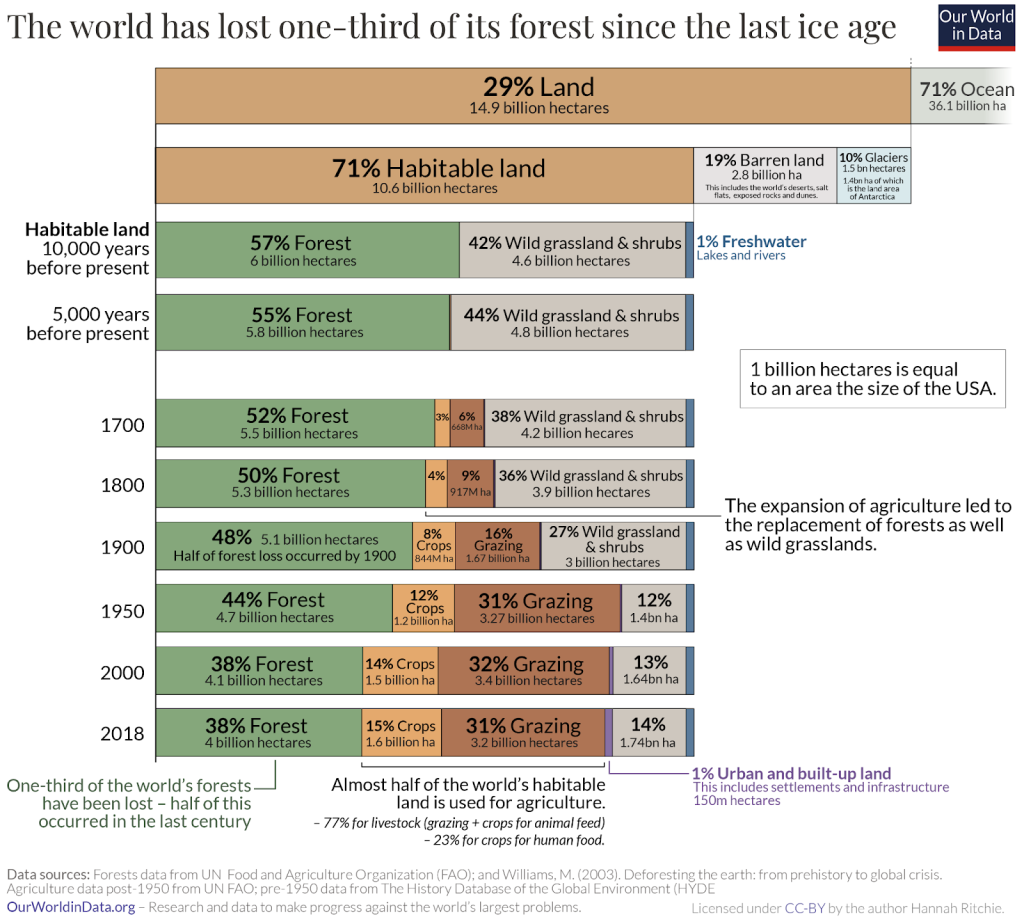
Reforestation is one of the simplest and most meaningful ways you can help preserve the environment and combat global climate change. Trees not only act as one of our largest carbon sinks, they also provide numerous benefits in addition to climate change mitigation.
These Are the Best Carbon Offsets for Reforestation in 2024
Below are our favorite carbon offsets for reforestation (you can click on their link to directly jump to their section in this article):
| Carbon Offsets for Reforestation | Quick Facts |
| The Arbor Day Foundation | About: Carbon offset purchases support third-party certified reforestation carbon offset projects including those in Mississippi, Nicaragua, and Peru. Costs: $40 per 1,000kg of CO2 |
| Reforest’Action | About: Carbon offset purchases support third-party certified reforestation carbon offset projects in Europe, North America, South America, Africa, Asia, and Oceania. Costs: $19.30 per 1,000kg of CO2 for a direct carbon offset, $20 per 1,000kg of CO2 for an offset subscription |
| Ecologi | About: Carbon offset purchases support third-party certified reforestation carbon offset projects including those in Madagascar, Mozambique, Bolivia, and Morocco. Costs: $6.04 per 1,000 kg of CO2 offset |
| Restore the Earth Foundation | About: Carbon offset purchases support reforestation in the Lower Mississippi River Basin in the US. Costs: Costs are determined after initial contact |
| One Tree Planted | About: Carbon offset purchases support reforestation in North America, Latin America, Africa, Asia, Europe, and the Pacific. Costs: $20 per 1,000kg of CO2 |
| The Carbon Offset Company | About: Carbon offset purchases support third-party certified reforestation carbon offset projects including those in the US, Senegal, Madagascar, Haiti, and Mozambique. Costs: Costs are determined after initial contact |
| GreenTrees | About: The GreenTree reforestation program partners with landowners to convert farmland into hardwood forest. GreenTrees currently plant trees in the South Eastern US, the Mississippi Alluvial Valley, and the state of Virginia. Costs: Costs are determined after initial contact |
| Carbonfund | About: Carbon offset purchases support third-party certified reforestation carbon offset projects including the Lower Mississippi Alluvial Valley Reforestation Initiative and the Panama Reforestation Project. Costs: $16.25-$17.16 per 1,000kg of CO2 for individuals, $390-$1,560 per year for small businesses, determined after initial contact for large businesses |
| Cool Effect | About: Carbon offset purchases support third-party certified reforestation carbon offset projects including The Giving Trees project in Kenya and Uganda. Costs: $8.79-$21.97 per 1,000kg of CO2 |
| myclimate | About: Carbon offset purchases support third-party certified reforestation carbon offset projects including those in Nicaragua and Uganda. Costs: $23-$30 per 1,000kg of CO2 |
The Arbor Day Foundation: Inspiring People to Plant, Nurture, and Celebrate Trees
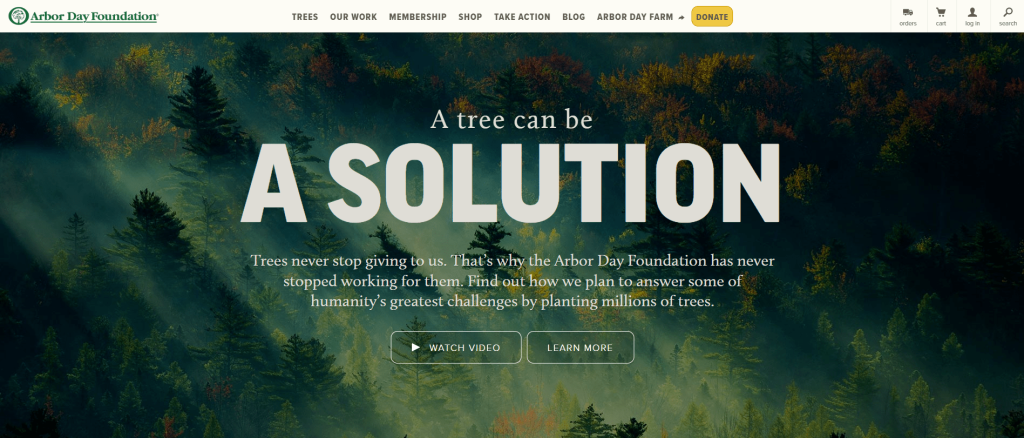
The Arbor Day Foundation was founded in 1972 by John Rosenow to commemorate the 100 year anniversary of Arbor Day, the oldest environmental holiday. Today, they are a nonprofit that has expanded to 55 countries and has planted over 500 million trees. They aim to both plant trees and help people understand their value.
“Let’s grow a movement”
The Arbor Day Foundation
Carbon offset overview: The Arbor Day Foundation has partnered with GreenTrees®, Taking Root, and Ecotierra to support reforestation projects in the Mississippi Alluvial Valley (US), Nicaragua, and Peru, respectively. These projects restore degraded agricultural lands, replenish soils, and resort forest canopy.
Carbon offset effectiveness: The Mississippi, Nicaragua, and Peru offset projects are certified according to the American Carbon Registry, Plan Vivo, and the Verified Carbon Standard, respectively. The Arbor Day Foundation’s offset projects also adhere to one or more of the UN’s Sustainable Development Goals.
Carbon offset costs: It costs $40 per 1,000kg of CO2 offset.
How to get your carbon offsets: You can visit Arbor Day’s website to purchase your carbon offsets.
Reforest’Action: Tackling Deforestation on a Global Level
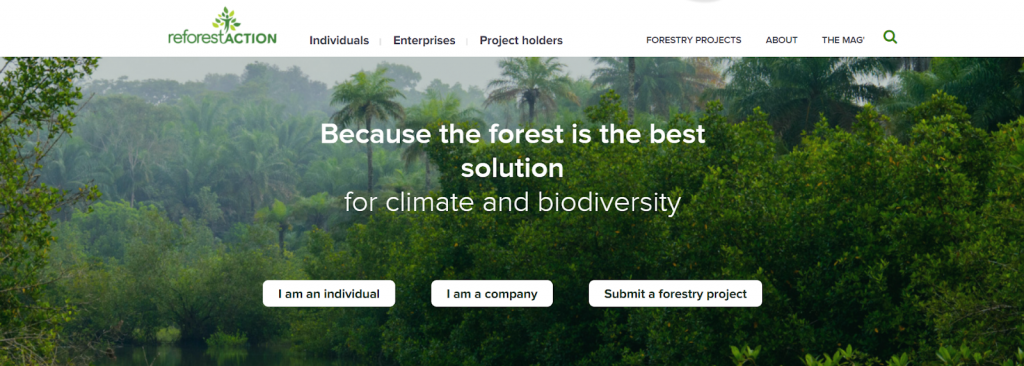
Reforest’Action was founded in 2010 by Stéphane Hallaire as a French crowdplanting company. Today, they have financed more than 20 million trees in 40 different countries in order to preserve, restore, and create forests on a global scale.
“Because the forest is the best solution for climate and biodiversity”
Reforest’Action
Project overview: Reforest’Action currently has active reforestation projects in Europe, North America, South America, Africa, Asia, and Oceania. 1 carbon offset is equal to 907 kg (1 ton) of CO2 through Reforest’Action, and you can either purchase offsets or plant trees to support specific projects in countries including, but not limited to, Haiti, Peru, Brazil, the US, Belgium, Portugal, the Ivory Coast, and Indonesia.
Carbon offset effectiveness: Reforest’Action’s projects are third-party verified by Ecocert Environnement, a leader in the field of forestry and reforestation.
Carbon offset costs: It costs approximately $19.30 per 1,000kg of CO2 for a direct carbon offset and $20 per 1,000kg of CO2 for an offset subscription. You can also plant or gift trees at a cost of $3.30 per tree.
How to get your carbon offsets: You can purchase your reforestation carbon offsets by first visiting Reforest’Action’s carbon footprint calculator. Reforest’Action also offers the option to plant trees, gift trees, or subscribe to a monthly plan.
Ecologi: Where Carbon Reduction Partners with Reforestation
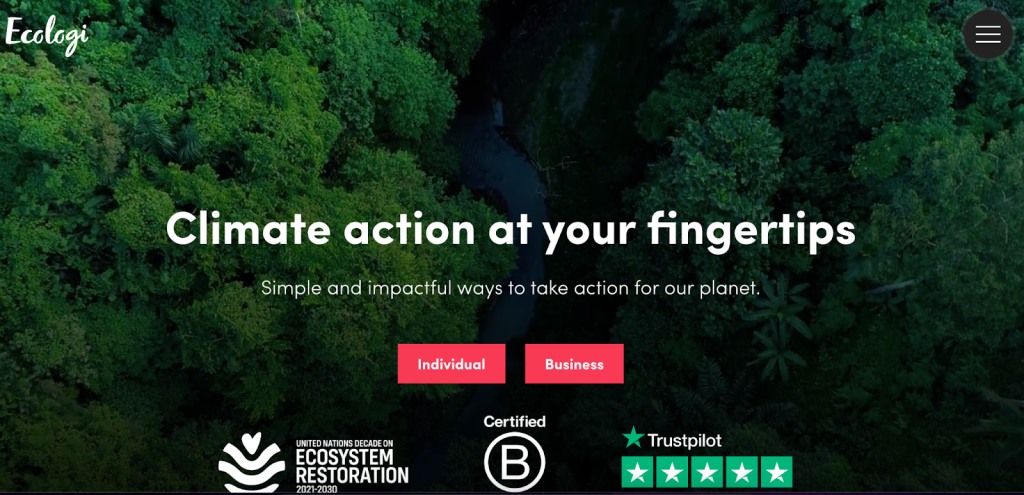
Ecologi was founded in 2019 by Elliot Coad, Lucy Jack, and Alex Price as an answer to the question “what if I put the money from my morning coffee into climate action”? Today they have funded over 57 million trees, avoided over 2 million tons of carbon, and continue to enable everyday people to tackle the current climate crisis via reforestation and carbon offsetting projects.
“For less than the cost of a cup of coffee per week you can become climate positive.”
Ecologi
Project overview: When you purchase carbon offsets through Ecologi, trees are planted as a bonus, because it takes years for trees to mature and sequester carbon in large quantities.
Examples of reforestation projects include Mangrove Planting in Madagascar, Reforestation in Mozambique, Protecting and Restoring Andean Forests in Bolivia, and Saving Endemic Fruit Tree Species in Morocco.
Carbon offset effectiveness: Ecologi’s reforestation and carbon offsetting projects are certified by either the Gold Standard or the Verified Carbon Standard. Their reforestation partners include Eden Reforestation Projects, One Tree Planted, and Trees for the Future, all of which are included in our list of the Best Charities for Reforestation. And they also have an interactive google sheet where you can check when, where, and how many trees are planted through their platform.
Carbon offset costs: It costs approximately $6.04 per 1,000 kg of CO2 offset. Ecologi has a personal offset plan where you choose how many trees get planted (12, 24, or 48) for a price ($10.50, $21, or $42 per month). And if you scroll further down, you can plant 1 extra tree in the US for only $1.20 per month.
How to get your carbon offsets: You can visit Ecologi’s website to select your personal carbon offset plan and get your reforestation carbon offsets.
Restore the Earth Foundation: Restoring The Earth’s Essential Forest And Wetland Ecosystems
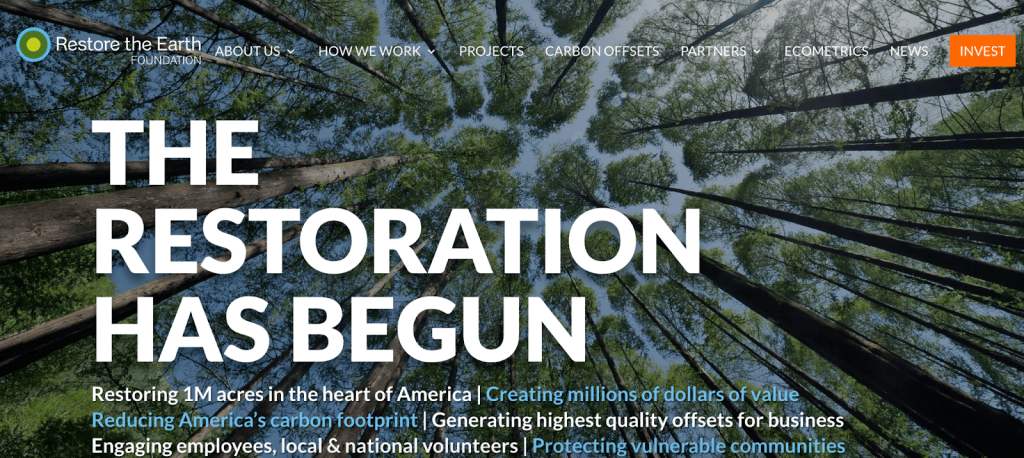
Restore the Earth Foundation was founded in 2008 by Marvin and PJ Marshall after Hurricane Katrina devastated the southern US in 2005. Today, they have reforested over 100,000 acres of forest along the US Gulf Coast and aim to restore 1 million acres total in the Lower Mississippi River Basin.
“The restoration has begun.”
Restore the Earth Foundation
Carbon offset overview: Restore the Earth plants trees in the Lower Mississippi River
Basin, also known as the North American Amazon. This 1 million-acre area is the most ecologically damaged region in North America, where over 80% of forested wetlands have already disappeared. Restore the Earth’s overall goal is to plant 100 million trees, a process which generates reforestation carbon offsets.
Carbon offset effectiveness: Restore the Earth Foundation’s reforestation offsets are certified according to either the Climate Action Reserve, American Carbon Registry, or Verified Carbon Standard.
Carbon offset costs: Costs are determined after initial contact.
How to get your carbon offsets: You can visit Restore the Earth’s website to contact a representative and get your carbon offsets.
One Tree Planted: A Non-Profit Focused On Global Reforestation
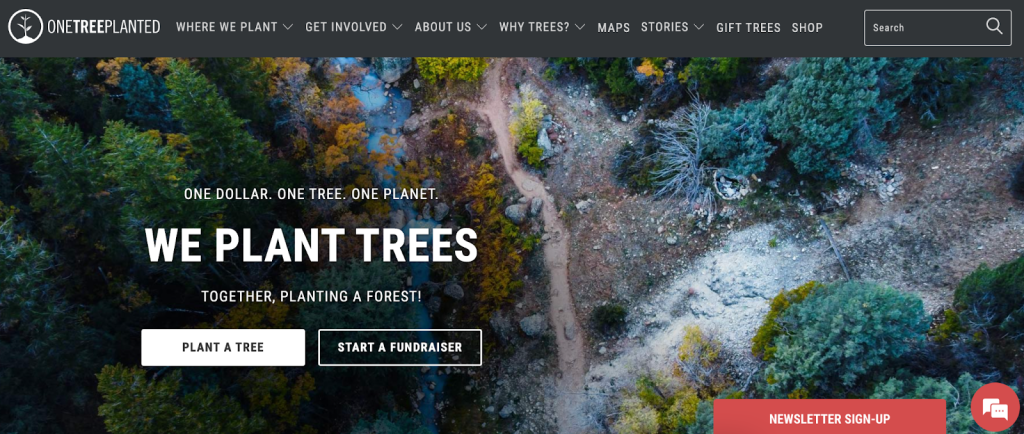
One Tree Planted was founded in 2014 by Matt Hill as a way to make it easier for individuals and businesses to aid in environmental conservation and reforestation across the globe. Today, they have planted over 40 million trees in more than 47 countries.
“One dollar. One tree. One planet.”
One Tree Planted
Carbon offset overview: One Tree Planted is a nonprofit environmental organization that plants trees in North America, Latin America, Africa, Asia, Europe, and the Pacific. Example reforestation offset projects include reforestation in areas affected by wildfires in California and restoring native flora in Romania. One of their more ambitious projects is AFR100, which aims to restore 100 million hectares of deforested & degraded land in Africa.
Carbon offset effectiveness: One Tree Planted’s offsets are certified by the Climate Action Reserve and are retired on a monthly basis.
Carbon offset costs: One Tree Planted offers 3 offset options that offset 10, 20, and 30 tonnes of CO2 at a cost of $20 per 1,000kg of CO2.
How to get your carbon offsets: You can visit their website to view their plans and purchase your carbon offsets.
The Carbon Offset Company: Reforestation and Carbon Offset Projects
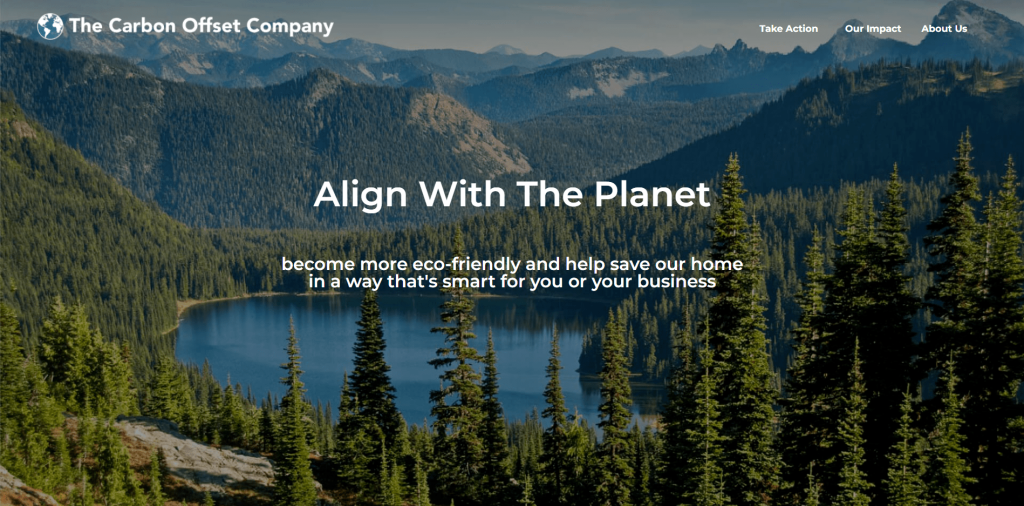
The Carbon Offset Company was founded in 2020 by Matt Kalstrom as a way for individuals and businesses to join the climate battle. Today, they manage reforestation carbon offset projects in 5 countries, have planted over 1.5 million trees, and have offset over 1 million pounds of CO2.
“5 countries. 88 projects. Countless lives changed.”
The Carbon Offset Company
Project overview: The Carbon Offset Company plants trees in the US, Senegal, Madagascar, Haiti, and Mozambique. Example offset projects include restoring areas in California and Florida that have been devastated by wildfires, mangrove and Papaya restoration and reforestation in Haiti, and mangrove reforestation in Mozambique.
Carbon offset effectiveness: The Carbon Offset Company’s offsets are verified by independent, third-party auditors including the Climate Action Reserve, Verified Carbon Standard, Climate, Community and Biodiversity Standard, American Carbon Registry, and the United Nations Clean Development Mechanism. Their reforestation partners include Trees for the Future, Plant With Purpose, National Forest Foundation, One Tree Planted, and Eden Reforestation Projects, all of which are included in our list of the Best Charities for Reforestation.
Carbon offset costs: Costs are determined after initial contact.
How to get your carbon offsets: You can visit their website to get in touch with a representative and get your carbon offsets.
GreenTrees: Reforesting the United States

GreenTrees was founded in 2003 by Carey Crane and Chandler Van Voorhis as a way to put a price on natural capital and link the biological world to the transactional marketplace. Today, their reforestation program has partnered with landowners to plant trees in three different areas of the US.
“Money does not grow on trees, it grows in them”
GreenTrees
Project overview: GreenTrees currently plant trees in the South East US, the Mississippi Alluvial Valley, and the state of Virginia. The GreenTree reforestation program partners with landowners to convert farmland into hardwood forests, a process that generates purchasable carbon offsets. The contract between GreenTrees and the landowner is 40 years, with the landowner agreeing to preserve the growing trees.
Carbon offset effectiveness: GreenTrees carbon offsets adhere to one or more of the UN’s Sustainable Development Goals.
Carbon offset costs: Costs are determined after initial contact.
How to get your carbon offsets: You can visit the GreenTrees website to get in touch with a representative and get your carbon offsets.
Carbonfund: Go Carbon Neutral
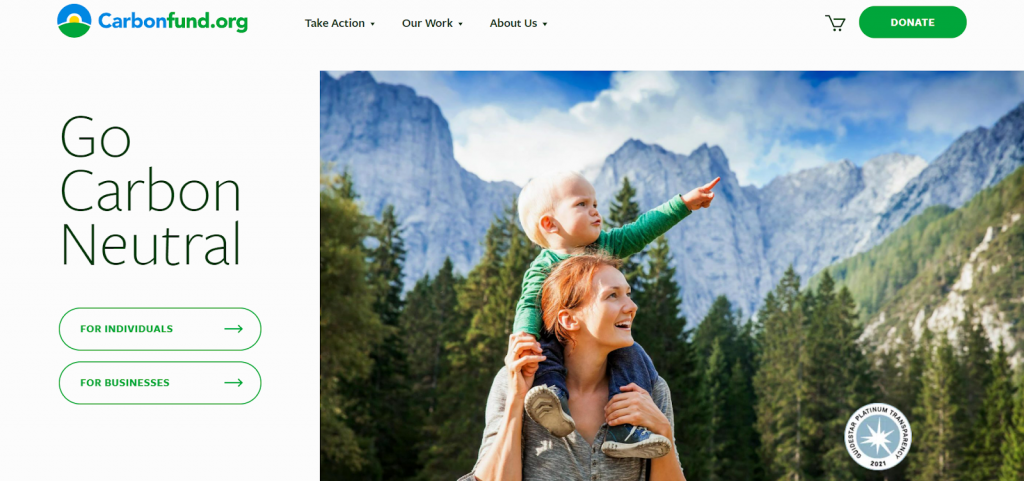
Carbonfund was founded in 2003 by Eric Carlson to make it easy for any individual, business, or organization to reduce and offset their climate impact. Today, they have been incorporated into ClimeCo and provide verified energy efficiency, renewable energy, and forestry carbon offsets for individuals and businesses.
“Reduce what you can, offset what you can’t.”
Carbonfund
Project overview: Carbonfund supports two reforestation carbon offset projects. The Lower Mississippi Alluvial Valley Reforestation Initiative aims to reforest 1 million acres in the southeast region of North America, and the Panama Reforestation Project aims to reforest 25,000 acres of abandoned cattle pastures in Panama.
Carbon offset effectiveness: The Lower Mississippi Alluvial Valley Reforestation Initiative is certified by the American Carbon Registry, and the Panama Reforestation Project is certified by the Climate, Community and Biodiversity Standard and the Gold Standard.
Carbon offset costs: Individual carbon offsets range from $16.25-$17.16 per 1,000kg of CO2, small business carbon offsets range from $390-$1,560 per year (dependent on the number of employees), and large business carbon offset costs are evaluated after personal contact.
How to get your carbon offsets: You can visit Carbonfund’s forestry webpage to learn more about their reforestation projects and purchase your customized individual offsets. You can also visit Carbonfund’s Carbonfree® Partner Program webpage to learn more about their small and large business options.
Cool Effect: Giving Like the Planet Depends On It
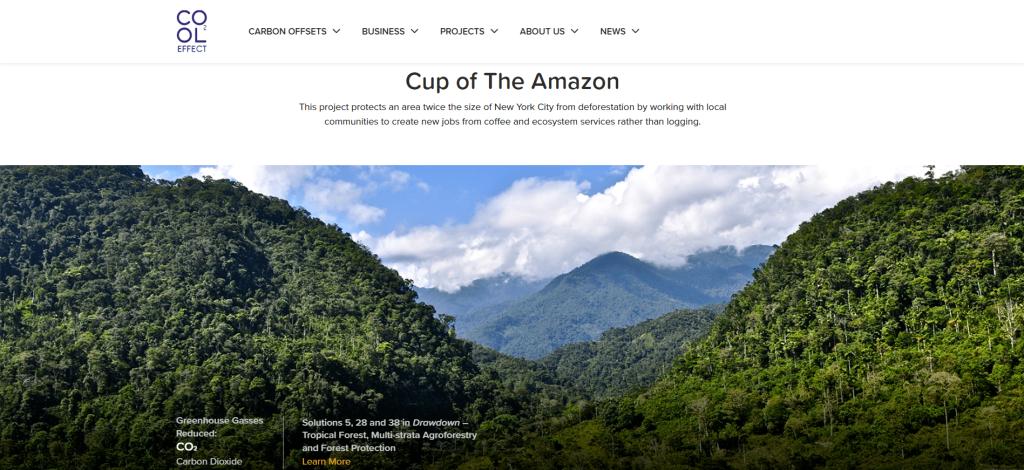
Cool Effect was founded in 1998 by Richard H. Lawrence, Jr. and Dee Lawrence as a small cookstove project in Honduras. Today, they have grown to represent a platform with 15+ global projects and a community of 500,000+ that aims to reduce carbon pollution globally.
“Carbon done correctly”
Cool Effect
Project overview: Cool Effect supports a variety of carbon offset projects including reforestation, clean cookstoves, methane capture, and blue carbon. An example reforestation project is the Giving Trees project in Kenya and Uganda, which doubles as a reforestation and sustainable development project. More than 90% of each dollar you donate goes directly toward the projects, with a fee of 9.87% to cover credit charges, research, and possible registration fees.
Carbon offset effectiveness: Cool Effect’s projects are 100% additional and are verified by either the Gold Standard, Verified Carbon Standard, or Climate Action Reserve. Each project is verified by one of the leading standards, an independent auditor, and Cool Effect each year, resulting in a triple verification process.
Carbon offset costs: An individual carbon offset purchase costs $14.62 per 1,000 kg of CO2 offset, and a specific project can cost anywhere from $8.79 – $21.97 per 1,000 kg of CO2. Some project pricing is determined after initial contact.
How to get your carbon offsets: You can visit Cool Effect’s carbon projects and pricing information webpage to get your reforestation carbon offsets.
myclimate: Shaping the Future
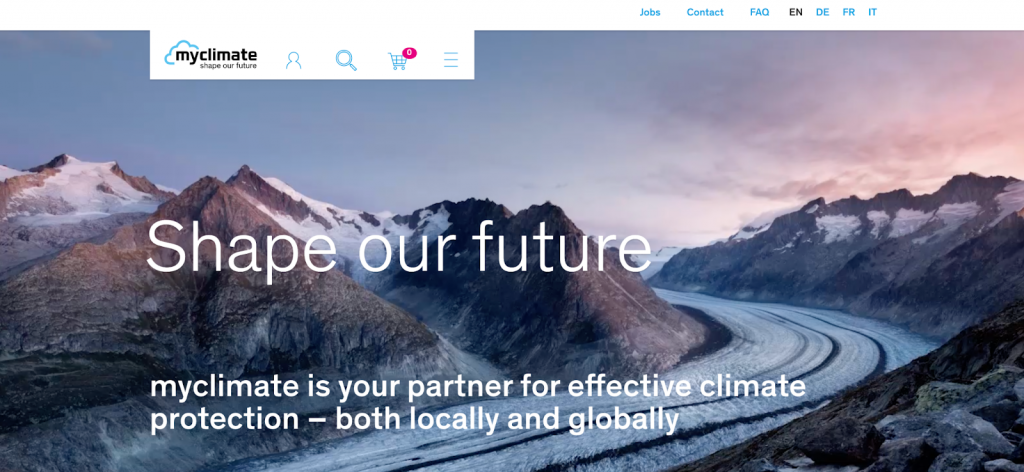
myclimate was founded in 2002 by Renat Heuberger, Thomas Camerata and Patrick Bürgi as an international climate organization with Swiss roots. Today, they have expanded to 45 countries and work with companies of all sizes, public administrations, non-profit organizations, and private individuals to provide high-quality carbon offset projects with quantifiable climate protection.
“myclimate is your partner for effective climate protection – locally and globally”
Myclimate
Carbon offset overview: myclimate provides individual carbon offsets for flights, cars, cruises, events, and your household. Purchases support reforestation projects including Community Reforestation in Nicaragua and Small-Scale Farmers Reforest Forests in Uganda.
Carbon offset effectiveness: myclimate projects are certified according to either the Gold Standard, Verified Carbon Standard, or Plan Vivo and contribute to the UN’s Sustainable Development Goals.
Carbon offset costs: It costs approximately $30 per 1,000kg of CO2 offset for an individual carbon offset and $23 per 1,000kg of CO2 offset for a monthly, quarterly, or annual offset subscription.
How to get your carbon offsets: You can visit myclimate’s website to offset your emissions from flights, cars, cruises, events, or your household. You can also enroll in a subscription or make a donation to myclimate’s mission by either contributing a certain dollar amount or offsetting a certain number of kg of CO2.
How Effective and Efficient Are Reforestation Carbon Offsets
In terms of effectiveness, reforestation carbon offsets reinforce our carbon sinks; however, they often lack permanence, do not reduce carbon emissions immediately, and do not reduce your own carbon emissions, which can lead to greenwashing
In terms of efficiency, reforestation carbon offsets are relatively cost-effective and continue to avoid CO2 emissions after their project life span; however, they also face carbon storage capacity limitations.
Reforestation carbon offsets are effective at mitigating climate change because they reinforce one of our largest carbon sinks capable of absorbing a net 7.6 bt of CO2 per year.
However, reforestation carbon offsets can also lack effectiveness because they:
- Often lack permanence because they are nature-based, reversible solutions
- Do not reduce carbon emissions immediately, because trees must first reach maturity before they can begin reducing emissions
Reforestation carbon offsets are efficient at reducing CO2 emissions because they:
- Are relatively cost-effective when compared to other methods of carbon emission reduction
- Can continue to reduce carbon emissions long after the trees have been planted.
However, reforestation carbon offsets can also lack efficiency because they face carbon storage capacity limitations.
Reforestation carbon offsets also do not reduce your own carbon emissions, which can lead to greenwashing. This occurs when emissions are only offset and not reduced from the source, and the consumer is deceived into thinking they are offsetting their emissions but in reality, they are not. This is why we should first reduce our emissions before relying on offsets.
What Are The 5 Pros and 4 Cons of Reforestation Carbon Offsets
Reforestation carbon offsets are cost-effective, reinforce our carbon sinks, preserve biodiversity, promote clean water, and allow us to reduce carbon emissions in ways we wouldn’t be able to accomplish individually.
However, reforestation carbon offsets also often lack permanence, do not reduce carbon emissions immediately, face carbon storage capacity limitations, and do not reduce your own carbon emissions, which can lead to greenwashing.
What Are the 5 Pros of Reforestation Carbon Offsets
Reforestation carbon offsets have various pros that make them effective at absorbing carbon from our atmosphere.
| 5 Pros of Reforestation Carbon Offsets | Quick Facts |
| #1: Reforestation offsets are cost-effective | Reforestation carbon offsets themselves are typically more cost-effective than other categories of carbon offsets. For example, reforestation offsets from leading providers (i.e., The Arbor Day Foundation, Reforest’Action, Ecologi, and One Tree Planted) cost less than $50 per ton of CO2 offset. |
| #2: Reforestation offsets reinforce our carbon sinks | Forests act as a giant carbon sink capable of absorbing a net 7.6 bt of CO2 per year and storing it in their leaves, trunks, roots, and surrounding soil. |
| #3: Reforestation offsets preserve biodiversity | Reforestation promotes biodiversity because forests support terrestrial and aquatic wildlife by providing habitats and helping to keep waterways healthy. Having a variety of plants and animals also sustains healthy ecosystems |
| #4: Reforestation offsets help maintain the water cycle | Trees capture, store, and use rainfall which aids in maintaining water quality and regulating the natural water cycle. When it rains, trees slow down the flow of water by absorbing it into the ground. This filters pollution and reduces flooding risks. |
| #5: Reforestation offsets allow us to reduce carbon emissions in ways we wouldn’t be able to accomplish individually | Reforestation carbon offsets allow us to reduce emissions from activities where sustainable alternatives are not yet widely available. |
What Are the 4 Cons of Reforestation Carbon Offsets
Understanding the drawbacks of reforestation carbon offsets is important when implementing this strategy on a large scale in order to mitigate climate change.
| 4 Cons of Reforestation Carbon Offsets | Quick Facts |
| #1: Reforestation offsets often lack permanence | Reforestation offsets often lack permanence because they are reversible. Trees die naturally, and environmental disasters such as floods, fires, changes in land use, and climate change itself can negate any permanence. |
| #2: Reforestation offsets do not reduce carbon emissions immediately | Carbon emission reductions are delayed when you plant new forests because you have to wait around 20 years for the trees to reach maturity before they can begin to reduce carbon emissions. |
| #3: Reforestation offsets face carbon storage capacity limitations | Trees can only store so much carbon. Their carbon storage capacity ranges from 10-40kg (22-88 pounds) of CO2 per year, which isn’t enough to compensate for all of our carbon emissions. |
| #4: Reforestation offsets do not reduce your own carbon emissions, which can lead to greenwashing | If emissions are only offset and not reduced from the source, this could lead to greenwashing, when the consumer is deceived into thinking they are offsetting their emissions but in reality, they are not. |
How Can Reforestation Carbon Offsets Help Mitigate Climate Change
Climate change is a severe and long-term consequence of fossil fuel combustion. Reforestation carbon offsets can help mitigate climate change because the more trees we plant, the more CO2 they can absorb from our atmosphere. Carbon in our atmosphere can, if left untreated, remain there for tens of thousands of years and exacerbate the negative effects of climate change.
How is Climate Change Defined
Climate change is arguably the most severe, long-term global impact of fossil fuel combustion. Every year, approximately 33 billion tons (bt) of CO2 are emitted from burning fossil fuels. The carbon found in fossil fuels reacts with oxygen in the air to produce CO2.
“Climate change: changes in the earth’s weather, including changes in temperature, wind patterns and rainfall, especially the increase in the temperature of the earth’s atmosphere that is caused by the increase of particular gasses, especially carbon dioxide.”
Oxford Dictionary
Atmospheric CO2 fuels climate change, which results in global warming. When CO2 and other air pollutants absorb sunlight and solar radiation in the atmosphere, it traps the heat and acts as an insulator for the planet. Since the Industrial Revolution, Earth’s temperature has risen a little more than 1 degree Celsius (C), or 2 degrees Fahrenheit (F). Between 1880-1980 the global temperature rose by 0.07C every 10 years. This rate has more than doubled since 1981, with a current global annual temperature rise of 0.18C, or 0.32F, for every 10 years.
As outlined in the 2015 Paris Climate Agreement, we must cut current GHG emissions by 50% by 2030 and reach net zero by 2050.
How Do Carbon Offsets Generally Help Mitigate Climate Change
Levels of carbon in our atmosphere that cause climate change have increased as a result of human emissions since the beginning of the Industrial Revolution in 1750. The global average concentration of carbon dioxide in the atmosphere today registers at over 400 parts per million. Carbon offsets can help prevent these levels from increasing even more.
When you hear the words “carbon offset”, think about the term “compensation”. Essentially, carbon offsets are reductions in GHG emissions that are used to compensate for emissions occurring elsewhere.
Carbon offsets that meet key criteria and verified project standards, are additional and permanent, and are a part of projects that are carried out until the end of their lifespan have the best chance of reducing carbon emissions and therefore reducing climate change.
When we offset CO2 we also slow the rate of global temperature rise, which in turn minimizes the effects of climate change.
How Do Reforestation Carbon Offsets Specifically Help Mitigate Climate Change
Reforestation offsets specifically help mitigate climate change because they plant more trees, and trees remove CO2 from the air as they grow. By increasing the number of trees on our planet, we increase the amount of carbon they are capable of storing. The more carbon our forests can sequester, the less carbon there is in our atmosphere. And because higher levels of carbon exacerbate global warming, less is better.
Final Thoughts
The Arbor Day Foundation, Reforest’Action, and Ecologi are the best reforestation (tree planting) carbon offsets. Restore the Earth Foundation, One Tree Planted, The Carbon Offset Company, and GreenTrees also offer reforestation projects on various continents. Carbonfund, Cool Effect, and myclimate offer a variety of reforestation carbon offset projects for both individuals and businesses.
Reforestation offsets plant trees in areas where there were once trees, helping to restore one of our largest carbon sinks. But for all of the good carbon offsets can instigate, they should not be seen as the only solution to climate change. They are effective at reducing CO2 in the short term, but in the long term, they fail to reduce CO2 enough.
When used in conjunction with direct CO2 reduction measures, carbon offsetting can be much more effective. We should reduce our own carbon footprint as much as possible first, and only then choose the most effective carbon offsets.
Stay impactful,

Sources
- U.S. Environmental Protection Agency: Offsets and RECs -What’s the Difference?
- Impactful Ninja: Why Is a Carbon Footprint Bad for the Environment? All You Need to Know
- United States Environmental Protection Agency System of Registries: Climate Change Terms – Carbon Footprint
- Britannica: Carbon Offset
- David Suzuki Foundation: Are carbon offsets the answer to climate-altering flights?
- The European Climate Adaptation Platform: Afforestation and reforestation as adaptation opportunity
- American University: Fact Sheet: What is Forestation?
- CLEAR Center: What is Carbon Sequestration and How Does it Work?
- Client Earth: What is a Carbon Sink?
- National Geographic: Deforestation
- Our World in Data: Deforestation and Forest Loss
- Impactful Ninja: What Are Reforestation Carbon Offsets and How Do They Work? The Big Picture
- The Arbor Day Foundation: Homepage
- The Arbor Day Foundation: About
- The Arbor Day Foundation: Carbon Offset Donation
- American Carbon Registry: Homepage
- Plan Vivo: Homepage
- Verified Carbon Standard: Homepage
- United Nations Department of Economic and Social Affairs: The 17 Goals
- Reforest’Action: Homepage
- Reforest’Action: Our Mission
- Reforest’Action: A Unique Model of Crowdplanting
- Reforest’Action: Our Reforestation Projects
- Reforest’Action: Calculate my Carbon Footprint
- Ecocert: Homepage
- Reforest’Action: Subscribe to the Forest!
- Reforest’Action: Offer a Tree
- Reforest’Action: I Plant Trees
- Ecologi: Homepage
- Ecologi: Reforestation and Carbon Offsetting Projects
- Gold Standard: Homepage
- Eden Reforestation Projects: Homepage
- One Tree Planted: Homepage
- Trees for the Future: Homepage
- Impactful Ninja: 9 Best Charities for Reforestation
- Ecologi: Ecologi Public Impact & Operations Ledger
- Ecologi: Your Plan
- Restore the Earth Foundation: Homepage
- Restore the Earth Foundation: Mission & Vision
- Restore the Earth Foundation: Carbon Offsets
- Restore the Earth Foundation: Projects
- Climate Action Reserve: Homepage
- Restore the Earth Foundation: Contact Us
- One Tree Planted: Homepage
- One Tree Planted: About us
- One Tree Planted: Where We Plant
- One Tree Planted: Plant Trees in California
- One Tree Planted: Plant Trees in Romania
- One Tree Planted: AFR100 – Plant Trees for Africa
- One Tree Planted: Carbon Offset
- The Carbon Offset Company: Homepage
- The Carbon Offset Company: A More Sustainable Future
- The Carbon Offset Company: Forestation and Carbon Offset Projects
- The Carbon Offset Company: Cornillon, Haiti
- The Carbon Offset Company: Casa Patrtida, Mozambique
- United Nations Framework Convention on Climate Change: The Clean Development Mechanism
- Plant With Purpose: Homepage
- The National Forest Foundation: Homepage
- The Carbon Offset Company: Verified Carbon Credits to Offset Your Emissions
- GreenTrees: Homepage
- GreenTrees: Global Leader in Reforestation
- GreenTrees: Where We Plant
- GreenTrees: North American Reforestation
- GreenTrees: Carbon Credits
- Carbonfund: Homepage
- ClimeCo: Homepage
- Carbonfund: About Carbonfund.org
- Carbonfund: Our Forestry/Reforestation Projects
- Carbonfund: Lower Mississippi Alluvial Valley Reforestation Initiative
- Climate, Community and Biodiversity Standard: Homepage
- Carbonfund: Panama Tropical Reforestation Project
- Carbonfund: For Individuals – Offset Your Carbon Footprint
- Carbonfund: Become a Small Business Partner
- Carbonfund: Become a Large Business Partner
- Carbonfund: Carbonfree® Partner Programs for businesses
- Cool Effect: Homepage
- Cool Effect: Our History
- Cool Effect: The Giving Trees
- Cool Effect: Our Approach
- Cool Effect: Scientifically Verified Carbon Projects and Pricing
- myclimate: Homepage
- myclimate: About myclimate
- myclimate: Flight Carbon Calculator
- myclimate: Car CO2 Emissions Calculator
- myclimate: Offset Your Cruise Carbon Footprint
- myclimate: Offset your event carbon footprint
- Myclimate: Climate Protection Projects
- myclimate: Community Reforestation in Nicaragua
- myclimate: Small-Scale Farmers Reforest Forests in Uganda
- myclimate: Carbon Offset Subscriptions
- World Resources Institute: Forests Absorb Twice As Much Carbon As They Emit Each Year
- Carbon Offset Guide: Permanence
- The Institute for Carbon Removal Law and Policy: Nature-Based Solutions
- EcoTree: How much CO2 does a tree absorb?
- Impactful Ninja: How Effective and Efficient Are Reforestation Carbon Offsets? Here Are the Facts
- Impactful Ninja: Reforestation Carbon Offsets: All 5 Pros and 4 Cons Explained
- Hurn River Watershed Council: Trees and Forests Fight Climate Change and Water Pollution
- The Environmentors: How Fast Does A Tree Grow?
- Edie: Carbon offsetting – How are businesses avoiding greenwashing on the road to net-zero?
- Natural Resources Defense Council: Global Warming 101
- myclimate: What does “net zero emissions” mean?
- National Oceanic and Atmospheric Administration: Climate Change – Atmospheric Carbon Dioxide
- Natural Resources Defense Council: Carbon Offsets 101
- Terrapass: Carbon Offset Projects
- The Ocean Foundation: Reduce Your Carbon Footprint
- Energy Information Administration: Renewable Energy Explained
- Energy Star: Compact Fluorescent Light Bulbs (CFLs) and Mercury
- Our World in Data: Where in the world do people have the highest CO2 emissions from flying?
- Zero Waste Europe: Reusable vs Single Use Packaging
- Carbonbrief: Interactive – What is the climate impact of eating meat and dairy?
- Stop Waste: Recycling and Climate Protection
- Impactful Ninja: Is Taking Long Showers Bad for the Environment?
- United States Environmental Protection Agency: Showerheads
- Impactful Ninja: 4 Main Reasons Why Reducing Your Carbon Footprint is Important




